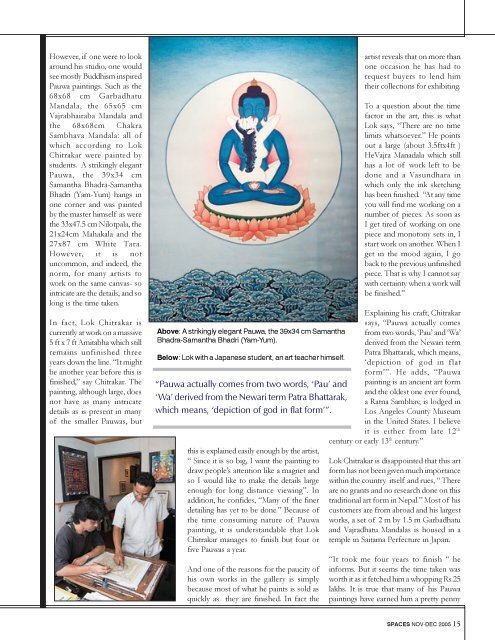Spaces Issue 7
Create successful ePaper yourself
Turn your PDF publications into a flip-book with our unique Google optimized e-Paper software.
However, if one were to look<br />
around his studio, one would<br />
see mostly Buddhism inspired<br />
Pauwa paintings. Such as the<br />
68x68 cm Garbadhatu<br />
Mandala, the 65x65 cm<br />
Vajrabhairaba Mandala and<br />
the 68x68cm Chakra<br />
Sambhava Mandala: all of<br />
which according to Lok<br />
Chitrakar were painted by<br />
students. A strikingly elegant<br />
Pauwa, the 39x34 cm<br />
Samantha Bhadra-Samantha<br />
Bhadri (Yam-Yum) hangs in<br />
one corner and was painted<br />
by the master himself as were<br />
the 33x47.5 cm Nilotpala, the<br />
21x24cm Mahakala and the<br />
27x87 cm White Tara.<br />
However, it is not<br />
uncommon, and indeed, the<br />
norm, for many artists to<br />
work on the same canvas- so<br />
intricate are the details, and so<br />
long is the time taken.<br />
In fact, Lok Chitrakar is<br />
currently at work on a massive<br />
5 ft x 7 ft Amitabha which still<br />
remains unfinished three<br />
years down the line. “It might<br />
be another year before this is<br />
finished,” say Chitrakar. The<br />
painting, although large, does<br />
not have as many intricate<br />
details as is present in many<br />
of the smaller Pauwas, but<br />
Above: A strikingly elegant Pauwa, the 39x34 cm Samantha<br />
Bhadra-Samantha Bhadri (Yam-Yum).<br />
Below: Lok with a Japanese student, an art teacher himself.<br />
“Pauwa actually comes from two words, ‘Pau’ and<br />
‘Wa’ derived from the Newari term Patra Bhattarak,<br />
which means, ‘depiction of god in flat form’”.<br />
this is explained easily enough by the artist,<br />
“ Since it is so big, I want the painting to<br />
draw people’s attention like a magnet and<br />
so I would like to make the details large<br />
enough for long distance viewing”. In<br />
addition, he confides, “Many of the finer<br />
detailing has yet to be done.” Because of<br />
the time consuming nature of Pauwa<br />
painting, it is understandable that Lok<br />
Chitrakar manages to finish but four or<br />
five Pauwas a year.<br />
And one of the reasons for the paucity of<br />
his own works in the gallery is simply<br />
because most of what he paints is sold as<br />
quickly as they are finished. In fact the<br />
artist reveals that on more than<br />
one occasion he has had to<br />
request buyers to lend him<br />
their collections for exhibiting.<br />
To a question about the time<br />
factor in the art, this is what<br />
Lok says, “There are no time<br />
limits whatsoever.” He points<br />
out a large (about 3.5ftx4ft )<br />
HeVajra Manadala which still<br />
has a lot of work left to be<br />
done and a Vasundhara in<br />
which only the ink sketching<br />
has been finished. “At any time<br />
you will find me working on a<br />
number of pieces. As soon as<br />
I get tired of working on one<br />
piece and monotony sets in, I<br />
start work on another. When I<br />
get in the mood again, I go<br />
back to the previous unfinished<br />
piece. That is why I cannot say<br />
with certainty when a work will<br />
be finished.”<br />
Explaining his craft, Chitrakar<br />
says, “Pauwa actually comes<br />
from two words, ‘Pau’ and ‘Wa’<br />
derived from the Newari term<br />
Patra Bhattarak, which means,<br />
‘depiction of god in flat<br />
form’”. He adds, “Pauwa<br />
painting is an ancient art form<br />
and the oldest one ever found,<br />
a Ratna Sambhav, is lodged in<br />
Los Angeles County Museum<br />
in the United States. I believe<br />
it is either from late 12 th<br />
century or early 13 th century.”<br />
Lok Chitrakar is disappointed that this art<br />
form has not been given much importance<br />
within the country itself and rues, “ There<br />
are no grants and no research done on this<br />
traditional art form in Nepal.” Most of his<br />
customers are from abroad and his largest<br />
works, a set of 2 m by 1.5 m Garbadhatu<br />
and Vajradhatu Mandalas is housed in a<br />
temple in Saitama Perfecture in Japan.<br />
“It took me four years to finish “ he<br />
informs. But it seems the time taken was<br />
worth it as it fetched him a whopping Rs.25<br />
lakhs. It is true that many of his Pauwa<br />
paintings have earned him a pretty penny<br />
SPACES NOV-DEC 2005 15

















